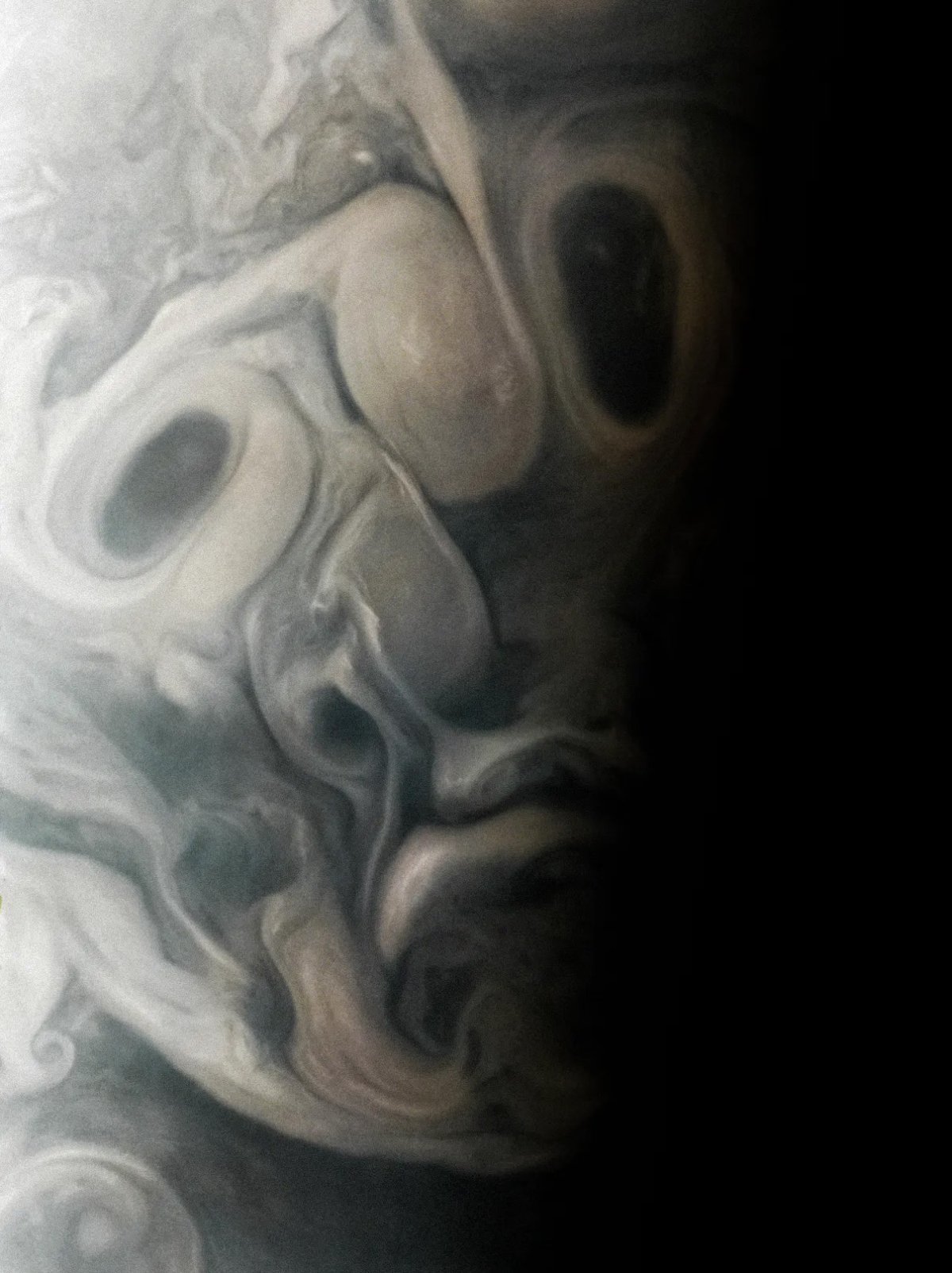Just in time for Halloween, a spooky face has been spotted hiding in plain sight on the surface of one of our planetary neighbors.
In the Jet N7 region of Jupiter, in the far north of the massive planet, this bizarre face was spotted hiding in the clouds.
The face was caught on camera by NASA's Juno mission on September 7, 2023, during its 54th close flyby of Jupiter. The face remained unnoticed until citizen scientist Vladimir Tarasov created the image using raw data from the JunoCam instrument.

"OK. I like it. Picasso!" NASA captioned the picture in a Facebook post.
"The #JunoMission captured this view in Jupiter's far north that resembles a cubist portrait displaying multiple perspectives. We present the NASA Solar System Exploration image to you on Oct. 25—what would have been Picasso's 142nd birthday."
Juno is a probe designed to orbit around and study Jupiter and its moons. Launched in August 2011, it entered a polar orbit around the gas giant in July 2016, having taken nearly five years to traverse the vast distance between Earth and Jupiter.
The two planets are 365 million miles away at their closest point, and 601 million miles away at their most distant.
Juno has been taking images of Jupiter's atmosphere and its moons for years, helping scientists to learn the secrets of our largest planetary neighbor.
The face is of course not a face, but a serendipitous arrangement of whirling storm clouds at the boundary between day and night. The image was snapped from around 4,800 miles above the clouds.
The phenomenon of seeing human faces in inanimate objects is known as pareidolia, which scientists have recently discovered is more common in women who have just given birth.




Our brains seem to look for faces in everything, and occasionally spot them in unusual places. This explains why cosmic images often appear uncannily similar to faces or objects here on Earth.
"Face pareidolia is when we see face-like patterns in inanimate objects and other contexts in which there isn't a real face. It's a bit like a mistake, or bias, made by the brain's face detection system," Robin Kramer, a senior lecturer in psychology at the University of Lincoln, told Newsweek.
"Our brains have evolved to be highly sensitive to faces and can detect them very quickly and easily—an important skill as a human being in a social world where other humans play such a vital role in our lives. The flipside of this highly evolved ability is that we might also notice faces where there aren't any, i.e., in a burnt piece of toast or the front of a car," Kramer said.
The reasons why we evolved this strange ability are unclear, but it's thought that it arose to help us spot predators lurking in the bushes.
"This would aid survival by allowing us to fight or flee, rather than being crept up on by hungry animals. But I'm not sure this is sound. If that were the case wouldn't we be seeing tigers' faces everywhere?" Kevin Brooks, an associate professor in human visual perception at Macquarie University, told Newsweek.
"A more likely proposition (in my opinion) is that being able to see a face (even with a very blurred image) will help a baby to orient toward that face, and encourage the bonding process with a caregiver. Babies that make eye contact are presumably more likely to be nurtured, grow up healthy and survive long enough to reproduce, creating more babies with a predisposition to spot faces," Brooks said.
"Later in life, faces are still very important stimuli, given that how social humans are, so the ability to spot them still presents an advantage. It's worth noting that there's little downside to detecting faces where there are none, but there is potentially a significant cost to missing a face where there actually is one."
While the planet's atmosphere is hydrogen and helium, Jupiter's roiling clouds are made of ammonia and water. These clouds often form into vicious storms, such as the characteristic Great Red Spot that has been raging for hundreds of years.
"Lightning on Jupiter is initiated in water clouds, similar to the terrestrial ones. The groups of pulses we have identified, indicate that the Jovian lightning evolves in distinct steps similarly as the terrestrial lightning does inside the clouds," Ivana Kolmašová, a scientist at the Institute of Atmospheric Physics of the Czech Academy of Sciences in Prague, previously told Newsweek.
"As lightning is an indicator of convection, we can be sure that the clouds could be electrified and we can also get more information about atmospheric chemistry," Kolmašová said. "The Jovian lightning discharges occur in the water clouds, which are hidden below the brownish clouds composed mainly from ammonia."
Do you have a tip on a science story that Newsweek should be covering? Do you have a question about Jupiter? Let us know via science@newsweek.com.
Uncommon Knowledge
Newsweek is committed to challenging conventional wisdom and finding connections in the search for common ground.
Newsweek is committed to challenging conventional wisdom and finding connections in the search for common ground.
About the writer
Jess Thomson is a Newsweek Science Reporter based in London UK. Her focus is reporting on science, technology and healthcare. ... Read more





